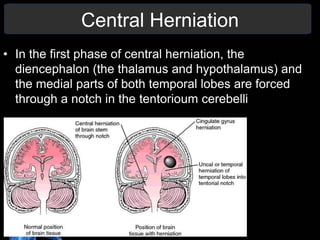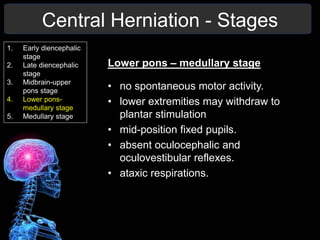Central Herniation Syndrome Typically Results in Which of the Following
Which of the following may result from seizure worsening the condition of the patient with a traumatic brain injury. -EXPANDING LESION BLOOD IN THE LATERAL MIDDLE FOSSA CAUSES THE UNCUS OF THE TEMPORAL LOBE TO BE FORCED DOWN INTO THE TENTORIAL NOTCH.

Brain Herniation Litfl Ccc Neurology
Intracranial hypotension typically results from loss of cerebrospinal fluid and CSF leak is the prevailing theory for the etiology of spontaneous intracranial hypotension 15-17.

. Hematoma and rarely lumbar spinal stenosis. Posterolateral disk herniation typically results in compression of the ipsilateral nerve. If the primary lesion becomes large enough uncal or central herniation may develop.
Your patient is a 60-year-old female driver of a vehicle involved in a moderate-speed frontal collision. 26 Central herniation syndrome typically results in which of the following. Herniated disc material and nerve irritation may induce the production of inflammatory cytokines which can include.
Cauda equina syndrome has an estimated prevalence of 1 in 30000 to 100000 peopley and an annual incidence of 15 to 34 per million people in the United States. This is typically attributed to the slightly posterior location of the nucleus pulposus relative to the midpoint of the vertebral body and reinforcement provided by the posterior longitudinal ligament at the midline posteriorly. Which of the following may result from seizure worsening the condition of the patient with a.
There is no damage to the windshield but the bottom of the steering wheel ring is deformed. Both temporal lobes herniate through the tentorial notch because of bilateral mass effects or diffuse brain edema. A Retrograde amnesia B Anterograde amnesia C Central neurologic hyperventilation D Cheyne-Stokes respirations.
Central cord syndrome occurs when the damage is in the centre of the cervical spinal cord. On your initial approach to the vehicle an EMT is in the back seat with manual cervical spine stabilization. - LATERAL DISPLACEMENT OF BRAIN TO SIDE OPPOSITE OF THE LESION.
A central herniation of cervical disc material produces central andor bilaterally referred symptoms. 1 Acute traumatic central cord syndrome ATCCS classically occurs in the setting of a hyperextension injury with preexisting cervical spine stenosis. A Anterograde amnesia B Central neurologic hyperventilation C Retrograde amnesia D Cheyne - Stokes respirations 26 27 Your patient is a 7 - year - old male pedestrian who was struck by a vehicle.
Posterolateral disk herniation typically results in compression of the ipsilateral nerve root as it exits the dural sac. Cauda equina syndrome CES is a rare serious neurologic condition with various presentations ranging from low back pain to loss of visceral function. Displacement of the hemispheres basal ganglia and diencephalon through the tentorial notch.
Upward transtentorial herniation can occur when a significant increase in intracranial pressure in the posterior fossa causes displacement of the central lobule and superior surfaces of the. As the lesion grows and herniation becomes prominent symptoms progress and patients may develop anisocoria a decreased level of consciousness changes in respiratory pattern changes in muscle tone and posturing. The central herniation leads to complete obliteration of peri-mesencephalic and peri-medullary cisterns truncated brainstem along with the presence of Duret hemorrhage.
This typically results in the loss of function in the arms but some leg movement may be preserved. She was unrestrained but airbags deployed. Central herniation is the subtype of downward transtentorial herniation of the brain that involves descent of the diencephalon and midbrain.
-PRESSES ON CRANIAL NERVE III POSTERIOR CEREBRAL ARTERY. Pressure and joint sensation may be preserved. Cervical disc herniation includes soft disc herniation andor hard disc protrusion the latter is often associated with bone spurs build-up along the spine edges.
Some control over the bowel and bladder may also be preserved. Central cord syndrome is the most common form of spinal cord injury SCI in the United States with approximately 11000 cases occurring each year most from traumatic etiology. Central herniation syndrome typically results in which of the following.
Central herniation syndrome typically results in which of the following. The patient is anxious and. DEATH IS THE USUAL RESULT.
It usually occurs with other types of downward herniation such as uncal herniation. As most bending motion in the cervical spine occurs at the C4-5 C5-6 and C6-7 levels disc herniation cervical canal stenosis and bone spurs occur typically at those lower levels. Cervical Cervical disc herniation CDH typically results in ipsilateral neck and arm pain corresponding to the level of the lesion.
For the head injury patient without signs of herniation adjust ventilation rates to maintain an end-tidal CO2 reading of between. The possible mechanism of the brain herniation in the present case may be related to changes in intracranial pressure secondary to CSF leak. Compressive forces can result in varying degrees of microvascular damage which can range from mild compression producing obstruction of venous flow that causes congestion and edema to severe compression which can result in arterial ischemia.
This type can occur when an infratentorial mass eg tumor in the posterior fossa cerebellar hemorrhage compresses the brain stem kinking it and causing patchy brain stem ischemia. In central or transtentorial herniation an expanding mass lesion of the midline frontal parietal or occipital lobe results in downward. Cauda equina syndrome is a surgical emergency because neurologic results are affected by the time to.
73 However false localizing CDH can present with.



0 Response to "Central Herniation Syndrome Typically Results in Which of the Following"
Post a Comment